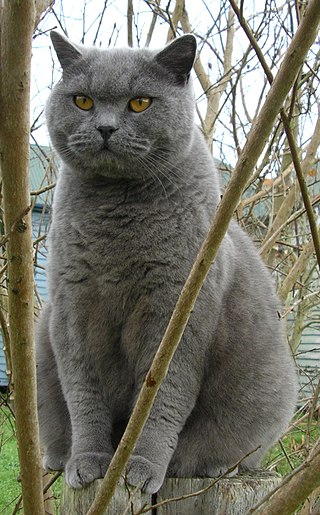
The British Shorthair is the pedigreed version of the traditional British domestic cat, with a distinctively stocky body, thick coat, and broad face. The most familiar colour variant is the "British Blue", with a solid grey-blue coat, pineapple eyes, and a medium-sized tail. The breed has also been developed in a wide range of other colours and patterns, including tabby and colourpoint.
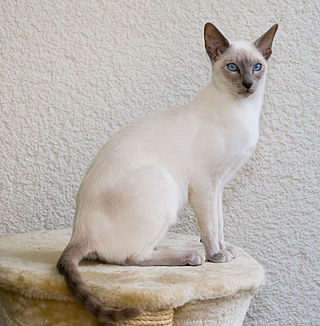
The Siamese cat is one of the first distinctly recognized breeds of Asian cat. Derived from the Wichianmat landrace, one of several varieties of cat native to Thailand, the original Siamese became one of the most popular breeds in Europe and North America in the 19th century. The carefully refined, more extreme-featured, modern-style Siamese is characterized by blue almond-shaped eyes; a triangular head shape; large ears; an elongated, slender, and muscular body; and various forms of point colouration. Other than colouration, the modern-style Siamese bears little resemblance to the original stock, and the more moderate, traditional, or "old-style" Siamese, with a much rounder head and body, has been re-established by multiple registries as the Thai cat. The International Cat Association describes the modern Siamese as affectionate, social, intelligent, and playful into adulthood, often enjoying a game of fetch. Siamese tend to seek human interaction and also like companionship from other cats.

A show cat is one that has been judged to be close to the physical ideal for its breed standard at a cat show. Not all pedigreed cats are show cats, many are just pets but the ones with the best conformation and personality are often shown in associations such as the CFA and TICA in the US, the GCCF in the UK or the FiFe in the rest of Europe. Uncommonly, a prize-winning pedigreed show cat can be worth thousands of dollars but most are loved pets. In order to compare examples of breeds and improve stock, cat shows are held where judges evaluate the cats according to a breed standard. Pedigreed cats are often identified with microchip implants.
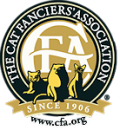
The Cat Fanciers' Association (CFA) was established in the United States in 1906. The CFA is currently the world's largest registry of pedigreed cats. Originally headquartered in Manasquan, New Jersey the CFA moved to Alliance, Ohio in 2010. The association's stated mission is preserving and promoting pedigreed breeds of cats while also enhancing the well-being of all cats. CFA's first licensed cat shows were held in Buffalo, New York and Detroit, Michigan in 1906. The association today has a known presence in Europe, China, and Japan along with its well-established activity in the United States and Canada.

The Oriental Shorthair is a breed of domestic cat that is developed from and closely related to the Siamese cat. It maintains the modern Siamese head and body type but appears in a wide range of coat colors and patterns. Like the Siamese, Orientals have almond-shaped eyes, a triangular head shape, large ears, and an elongated, slender, and muscular body. Their personalities are also very similar. Orientals are social, intelligent, and many are rather vocal. They often remain playful into adulthood, with many enjoying playing fetch. Despite their slender appearance, they are athletic and can leap into high places. They prefer to live in pairs or groups and also seek human interaction. Unlike the breed's blue-eyed forebear, Orientals are usually green-eyed. The Oriental Longhair differs only with respect to coat length.

The Siberian is a centuries-old landrace of domestic cat in Russia, and recently developed as a formal breed with standards promulgated the world over since the late-1980s. Since 2006, the breed is recognised for registry and championship status with all major cat registries.
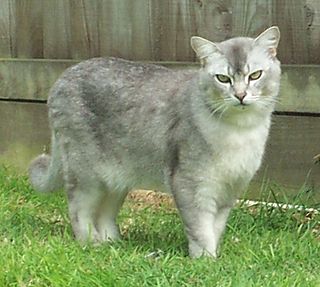
The Burmilla is a breed of domestic cat, that originated in the United Kingdom in 1981. It is a cross between the Chinchilla Persian and Burmese cats. In certain cat registries the breed falls under the Asian group, and is sometimes referred to as the Asian Shaded. Standards were produced in 1984, and the breed gained championship status in the United Kingdom in the 1990s.

The International Cat Association (TICA) is considered the world's largest genetic cat registry. Originally a North American organization, it now has a worldwide presence. The organization has a genetic registry for pedigreed and household pet cats and is one of the world's largest sanctioning bodies for cat shows.

The Ragamuffin is a breed of domestic cat. It was once considered to be a variant of the Ragdoll cat but was established as a separate breed in 1994. Ragamuffins are notable for their friendly personalities and thick fur.
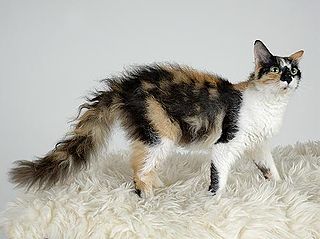
The LaPerm is a breed of cat. A LaPerm's fur is curly, with the tightest curls being on the throat and on the base of the ears. LaPerms come in many colors and patterns. LaPerms generally have a very affectionate personality.
A cat registry or cat breed registry, also known as a cat fancier organization, cattery federation, or cat breeders' association, is an organization that registers domestic cats of many breeds, for exhibition and for breeding lineage tracking purposes. A cat registry stores the pedigrees (genealogies) of cats, cattery names, and other details of cats; studbooks, breed descriptions, and the formal breed standards ; lists of judges qualified to judge at shows run by or affiliated with that registry, and sometimes other information. A cat registry is not the same as a breed club or breed society. Cat registries each have their own rules and usually also organize or license (sanction) cat shows. The show procedures vary widely, and awards won in one registry are not normally recognized by another. Some registries only serve breeders, while others are oriented toward pet owners and provide individual as well as cattery memberships, while yet others are federations only deal with breed clubs or even other registries as intermediaries between the organization and breeders.

The Thai or Wichien Maat is a newly renamed but old cat breed, related to but different from the Western, modern-style Siamese cat. This natural breed is descended from the cats of Thailand, and, among various groups of breeders in different times and places has also been called the Old-Style Siamese, Traditional Siamese, Classic Siamese; Wichien Maat ; and the Applehead, a nickname that originated in the 1950s. According to The International Cat Association: "The Thai is the breed dedicated to preserving the native pointed cat of Thailand in as close to its original form as possible."

An Oriental bicolour is any cat of Oriental type, either long-haired or short-haired and in any pattern including colourpoint, which has white areas on its coat caused by the white spotting gene. In most cat fancier and breeder organisations, Oriental bicolours do not constitute a standardised breed, but a coat pattern variant of the breed of their foundation stock. One breed registry is an exception, the UK-based Governing Council of the Cat Fancy (GCCF), which has defined them as a separate breed named Oriental Bicolour (capitalised).

The British Longhair is a medium-sized, semi-long-haired breed of domestic cat, originating in Great Britain.

The Canadian Cat Association is a non-profit organization in Canada whose mission is to promote the welfare of all cats in Canada, maintain a registry of pedigreed cats in Canada, and further the improvement of all breeds of cats in Canada. CCA-AFC is Canada's only globally-recognized national cat registry, with its pedigrees and registrations accepted by major global associations such as the Cat Fanciers' Association, The International Cat Association, and Fédération Internationale Féline. To date, CCA-AFC has registered over 190,000 cats.
The Supreme Cat Show is organised every year by the world's oldest cat registry, the Governing Council of the Cat Fancy, and used to take place each October at the National Exhibition Centre (NEC), in Birmingham, England. However, in 2022 it moved to the NAEC. Special awards of UK Champion and Supreme Champion can be gained at this show only. A contestant cat wins each show's "Best in Show" award.
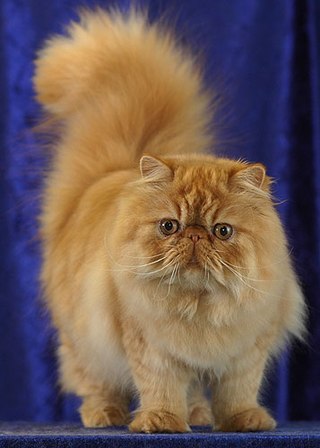
The Persian cat, also known as the Persian longhair, is a long-haired breed of cat characterized by a round face and short muzzle. The first documented ancestors of Persian cats might have been imported into Italy from Khorasan as early as around 1620, however this has not been proven. Instead there is stronger evidence for a longhaired cat breed being exported from Afghanistan and Iran from the 19th century onwards. Widely recognized by the North-West European cat fancy since the 19th century, and after World War II by breeders from North America, Australia and New Zealand. Some cat fancier organizations' breed standards subsume the Himalayan and Exotic Shorthair as variants of this breed, while others generally treat them as separate breeds.

Puppy cat is a term used to refer to specific breeds of domestic cats that have unusual behavioral tendencies that are reminiscent of young domestic dogs. These are within the scope of feline behavior, and may be enhanced through selective breeding. These behaviors, not specific to any breed, include following people around from room to room, the desire to receive frequent moments of physical affection such as being held and petted, a lack of aggression toward some fellow animals, and a placid nature. While these attributes are found desirable for owners interacting with their cats, problems can occur when the felines are exposed to dogs and people who wish to harm them, with the cats possibly being too trusting and too friendly for their own good. Breeds known for these canine behaviors include the Abyssinian, Burmese, Maine Coon, Manx, and Ragdoll, though dog behavior traits can appear regardless of breed.

















